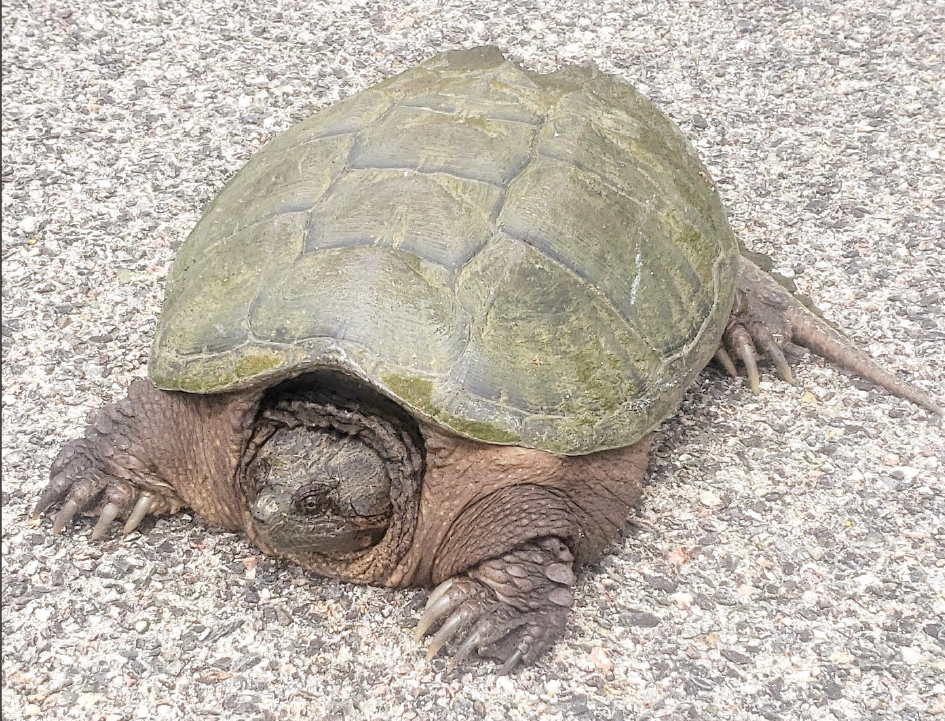How to help a turtle cross the road

by Bill Tefft
June 1 started the 2023 discussions among the Ely Field Naturalists from people with current and previous experiences meeting snapping turtles crossing a road. We have almost all stopped and moved a painted or other smaller turtle across the road and out of danger. Those contributions from Steve, Val, Carl, Johnnie, Kristi, Reid and others were matched and exceeded by conservations on roadsides, in coffee shops, between neighbors etc.
On June 19 I met this “snapper” just beginning to cross the Echo Trail. It was quite evident that it had just climbed from a wetland below the roadbed and was seeking not more wetland, not more bedrock, but instead soil/gravel. Maybe the road shoulder or beyond would accommodate her digging with hind legs and burying eggs.
My presence drew the attention of passersby, one vehicle after another. Curiosity overcame me as I talked to the turtle eye to eye while noticing the leech and other parasites on its hind feet.
It would have been wise to assist it across the road before a couple of cars stopped by to see if I was okay. Then a neighbor from up the road stopped to assist, and we discussed methods for transport of this large female.
The turtle turned occasionally to face us as we discussed a few given factors in moving large snapping turtles. First, a safer place to be is away from the head and approach from the rear. But do not grab the tail and lift or drag her. All the weight and resistance would be on the tail and back vertebrae. It’s obvious, no one would do that to their dog for example.
Second, in the interest of lifting and moving while approaching from the back, the turtle’s upper shell (the carapace) could be grabbed on the sides closer to the center of body weight but away from the head. This can be possible, but by ignoring the hind feet flailing with large claws, scratched hands are likely.
The third option involves a different approach to the idea of the second option. It makes sense to lift the turtle and carry it (faster than turtle speed) across the road. Some roads are marked with turtle crossing signs, but allowing the turtle to move at turtle speed takes considerable patience.
There is more than one way to lift a large snapping turtle. One way is to grab the rear end of the carapace with hands side by side behind the rear legs and lift. This will only get the rear end off the ground. Step two is needed so be prepared for turtle egg laying season by having something to put under the turtle. Some people keep a snow shovel in their car year-round to slip under a larger turtle, but it still may be difficult to keep the turtle on the shovel for a slide to the other side of the road.
Other, and probably easier accessories, are a car floor mat, piece of cardboard, or another large flat object to place behind the turtle. After grabbing the carapace and the edge of the turtle transport accessory, drag the turtle to safer point on its journey.
One last method that was recommended, and I have used a couple of times, is another variation on lifting snapping turtles that were not giants or very heavy. I pressed down on the rear of the carapace with one hand and grabbed. Then lifting with that hand, I could slide my free hand under the lover shell (the plastron) to a point nearer the center of the body underneath. Then lifting from underneath, holding from the rear, and keeping turtle feed off the ground, I could carry the turtle to safety. Or give some watchers from a van a closer look at a snapping turtle on the way.
MOST IMPORTANTLY – RESPECT TURTLES NEEDS TO CROSS A ROAD TO LAY EGGS
They can potentially live many years and have great challenge to lay eggs and to have those eggs survive predators that dig up and prevent eggs from hatching.














